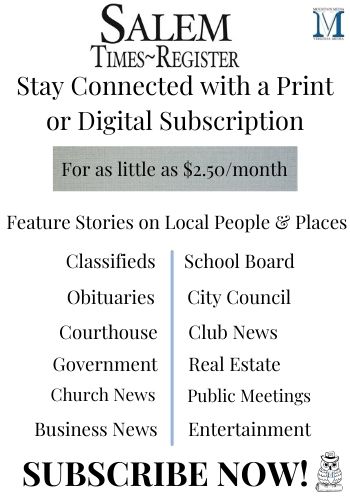Frances Stebbins, Correspondent
[This is a memory from the many decades the author has been privileged to write for daily and weekly newspapers circulating in Western Virginia.]
Before Wikipedia, there was “The Volume Library.”
A one-volume encyclopedia holding more than 1,200 thin paper pages, it was where I turned in childhood when I had “a composition” to write for my elderly teacher in the tiny school I attended for five years.
It still occupies a space on the office bookshelves my son-in-law made for me 30 years ago, but it hasn’t gotten any lighter. It’s bound in a brick-red ordinary cotton and on the inside cover, it bears an inscription in my fifth-grader hand:
Frank Stringfellow III
August 2, 1939, Orange, Virginia
That inscription says a great deal about the Great Depression –1929 through 1941 – and about my childhood life.
First, the inscription. It was what I liked to be called from around seven to ten years old, for I wished I was a boy and then the name would have fitted me. It was my father and grandfather’s name. My parents had named me “Frances’ as the feminine form of “Frank” when I was rather untimely born late in their marriage.
I say “untimely,” for my father was terminally ill with tuberculosis; he died six months later leaving my mother at 40 to raise me alone. She did so as a small farmer of poultry. A Higher Power spared her to do this until I was 19, in college, and nearing the age of independence.
So, I never knew my father, but I idolized his memory and wished I had his name. That all gradually passed as I grew into adolescence and my own identity. I fell in love at 19 and had a rewarding marriage for nearly 57 years.
Back to “The Volume Library.”
Perusing the aging book, I see that it was published by something called Educators Association in New York with the latest edition copyrighted in 1936 following others going back to 1911.
The publishers in a lengthy Preface, explain that although there are several compilations of knowledge available, it seems something was needed that was concise and usable both by growing children for their schoolwork and adults just wishing to advance their knowledge.
Once in a while I still drag it off the shelf to get a brief biography of a classical composer; my view of my favorite George Frederick Handel wearing his 18th Century wig, comes from “The Volume…”
There are 15 major chapters in this encyclopedia. Each contains a number of articles by scholars whose credentials are cited. For example, the first chapter, Education, covers Pages 3-62. It includes aims in education, the psychology of children, well-known educators, subjects expected to be taught in certain grades and descriptions of all sorts of jobs and how much training is needed for them.
{Here, if one had time to delve into the way “education” was viewed more than 80 years ago, a lot could be gleaned. It was the era that “progressive education” rather than a lot of memory drills were favored. Now such controversies as how to teach about slavery have taken over. There’s nothing though that can cause bitter divisions more than what one’s children are to be taught. As a mother of two sons with Attention Deficit Disorder, I speak from years of frustration.}
The other 14 Chapters are: Language and Grammar, Literature, History, Geography, Trade and Industry, The Atlas, (Detailed maps of every state and the nations of the time), Multiplex Dictionary, Biography, Mathematics, Science, Hygiene, Government and Law, Fine Arts and Useful Miscellany.
Each is treated in the detail I described in the opening chapter on Education.
Throughout my life I have consulted the volume, especially for my interests that included all but mathematics, science and government and law.
The History Chapter has a summary with small pictures of the Presidents of the United States from George Washington to Franklin D. Roosevelt and the dates of their administrations. The pictures illustrate major events in their times in office. Needless to say, a lot has happened since 1936.
The chapter on Hygiene I read avidly in my late childhood when I wanted to do something medical in adulthood.
I have no idea what my mother paid for “The Volume Library,” but I remember that it was sold to her by a young man who drove out to our home on the edge of our small town. In those days, it might well have cost no more than a few dollars.
Too, it came with a big wall map which my mother hung in the room our stove heated best in winter. One side of the map showed clearly every state with its larger communities. The other was the world as it existed in the years between the two major world wars.
I learned a lot from that big book and its accompanying map. Now falling apart, it was worth every cent!









